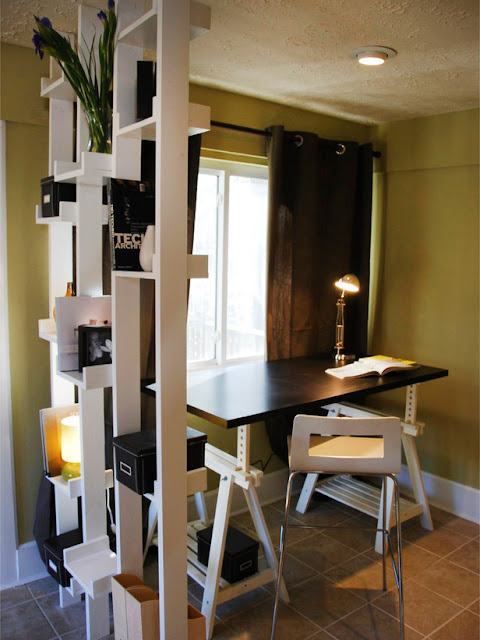Instantly transform simple store-bought panels into something special with these quick and easy window treatment ideas.
Designed by Elaine Koonce
Flower Style
Faux flowers find a new use on these panels. Randomly placed flowers add dramatic visual appeal to plain green window panels. For a look that's not as cohesive and a little more fun, choose a variety of faux florals for a flower patch panel.
Flower Style: Make It
How to Make ItGo to a craft store and find faux flowers that fit the look you're going for.
Pop flower heads off the stems.
Arrange flower heads on a panel and glue in place with a hot-glue gun.
Tip: Lay down protective covering on working surface to keep glue from leaking through.
Branching Out
Achieve a designer look at the fraction of the price with this creative design. Search your local fabric store for discount fabric that can be used to create window panels. Then put your creativity to the test by sketching out a leafy design that fits your style.
Branching Out: Make It
How to Make ItFor one large branch, trace out the pattern first with a white chalk.
Make three size leaves on card stock; cut out pattern.
Trace the leaves on the branch pattern.
Using acrylic or fabric paint, hand-paint branch and leaves.
Let dry. Use a cloth to wipe off excess chalk.
Button Burst
Fun and whimsical, this unique look is simple to duplicate. All you need are a handful of buttons and some creativity.
Button Burst: Make It
How to Make ItArrange the buttons in a pattern you like on the panel.
Using fabric glue, glue the buttons into place.
Lay flat to dry.
Sheer Elegance
Romanticize any room with this bold drapery that beckons the princess inside us all. A pretty two-tone effect adds visual interest but does not take away from the beautiful delicacy of the detailing in the sheers.
Sheer Elegance: Make It
How to Make ItMake a cut at the top of the sheer, tear (do not cut across).
Fold over and iron, repeat.
Sew seam.
Fold sides over (twice) and iron and sew.
Sew the top of the sheer to the top of the panel.
Cut the bottom length 2 inches longer than the panel; iron, fold and hem.
Finish off with a diamond belt clip.
Say It with Stencils
These floor-length panels are great for a kids' playroom or bedroom. Not only will your little ones love seeing their names in big letters, but they can help make these easy treatments.
Say It with Stencils: Make It
How to Make ItPurchase 9-inch oil-based board stencils.
Overlap boards so letters are at the desired distance apart.
Trace stencil with a pencil; remove the cardboard stencils.
Paint inside the drawn lines.
Blocked Beauty
From traditional to modern, this treatment is perfect for any decorating style. Sheer blocks allow some light into the room but do not take away from the privacy functionality of a solid panel.
Blocked Beauty: Make It
How to Make ItLay panels flat, then place three poster boards cut to 14 x 22 inches on top, making sure the distance between the three boards is even.
Use a white chalk to trace around the boards; remove boards.
Cut out squares.
Lay your sheer fabric over the holes, pin into place and cut the sheer to size.
Move the panel to an ironing board. Lay flat again and use iron-on adhesive to secure in place. (Make sure iron is on medium heat so you don't melt the sheer.)
Use 7/8-inch chocolate grosgrain ribbon to finish off front cuts and secure with a 3/4-inch iron-on adhesive.
Iron both front and back to help adhere the adhesive.
Top It with a Scarf
Scarves are a great way to add color and texture to your treatment, yet still maintain a tailored look. If you're having trouble finding two of the same kind, opt for scarves that have similar patterns or colors.
Top It with a Scarf: Make It
How to Make ItPurchase two women's dress scarves in patterns and colors that fit your decor.
Cut in half, hem.
Lay them over top of panel and pin in place.
Sew one at a time (bottoms scarf first).
Trim & Ribbon Treatment
You can take any pair of plain drapes and dress them up in a few easy steps. Because the panels are embellished only in thin stripes, the more detail the better. We chose to use several types of ribbon, buttons, and beaded trim for our treatment, but the list of embellishments is endless.
Trim & Ribbon Treatment: Make It
How to Make ItPurchase several different ribbons, trims and buttons in the color combination of your choice.
Plan an arrangement of layers.
Measure and draw a line across the panel to line up the beaded trim. Continue to add the other layers above and below the center ribbon.
Use an iron-on adhesive for the ribbon and flat trims.
Use fabric glue for the smaller, round, and irregular shaped trims.
To complete the look, glue on buttons.
Ribbon Masterpiece
It's never been simpler to take an existing window panel and make it fabulous. If you are new to do-it-yourself projects, this embellished window treatment idea is perfect for you.
Ribbon Masterpiece: Make It
How to Make ItPurchase three colors and sizes of ribbon.
Cut large ribbon to 8 inches, second size to 6 inches, and small to 4 inches.
Iron all ribbon in half.
Line up the three sizes together, pin in place and sew a quick stitch at top to secure.
Draw a line across the panel where embellishment is desired.
Pin ribbon blocks in place. Then stitch across the length of the ribbon to secure it to the panel (you can also use iron-on adhesive to make this a no-sew project).
Using an iron-on adhesive, secure medium and small ribbon in horizontal strips, to complete the look.






































































